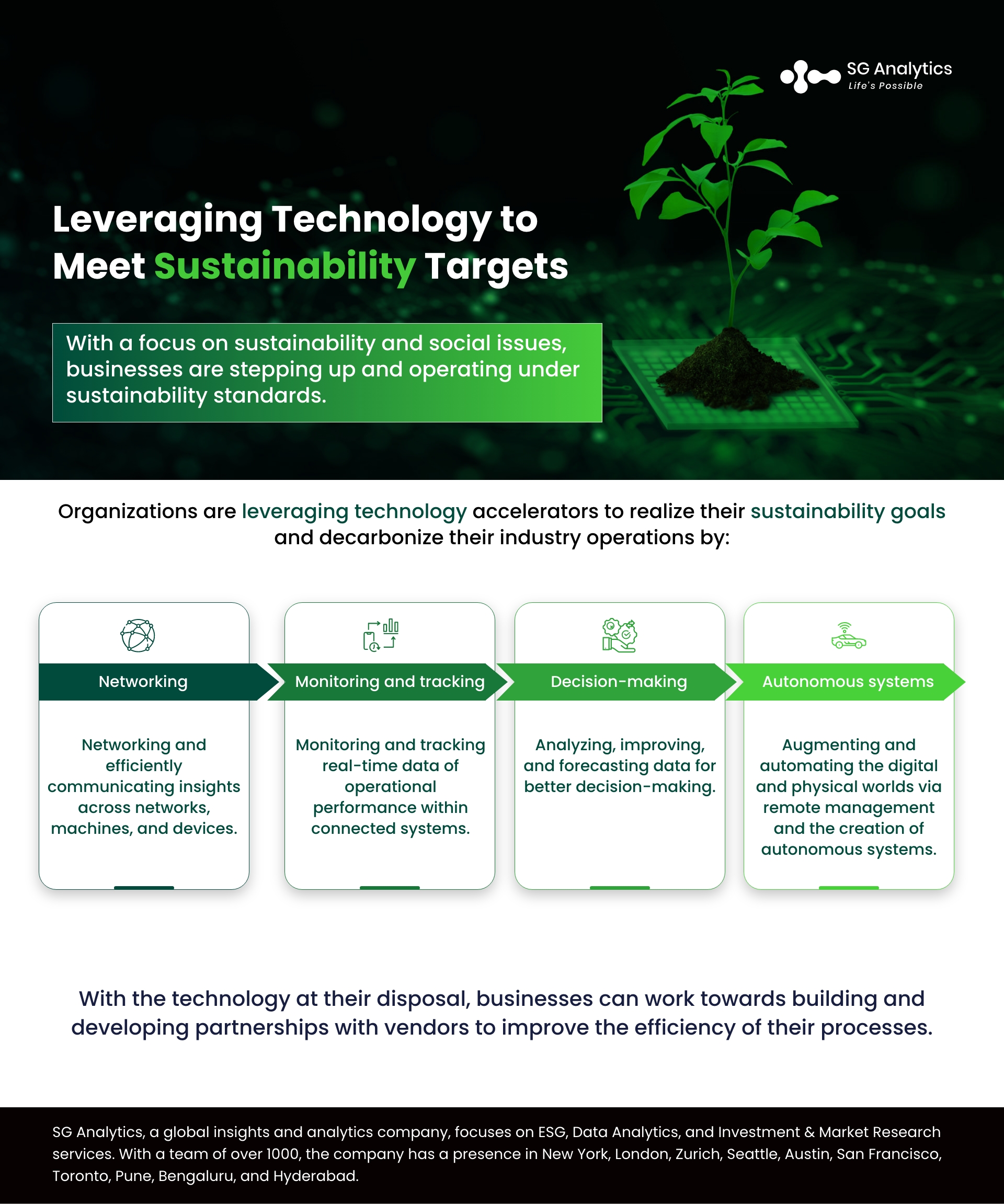In the past decade, sustainability has risen to the forefront of public interest and government agendas. It is no longer a checklist exercise but a key strategic imperative for environmental, economic, and social growth.
With a focus on sustainability and social issues, businesses are stepping up and operating under sustainability standards. Today, businesses are setting more ambitious environmental, social, and governance (ESG) goals, and sustainability and technology strategies become more tightly aligned and gain competitive advantage while creating a lasting positive impact on society and the environment. This is driven not only by regulations but also by end customers and investors providing funding for strategic development. A sustainable technology strategy embeds sustainability in technology, drives sustainability with the help of technology, and scales sustainability by engaging with the technological ecosystem.
Chief sustainability officers, along with other industry leaders, have been spearheading environmental sustainability efforts to meet those goals. This strategy is enabling companies to deliver 360° value as well as contribute to the achievement of their broader sustainability goals.
Read more: The Intersection of Technology and Sustainability to Overcome the ESG Dilemma
Reducing the Carbon Footprint of AI Operations
An environmentally aware enterprise thinks more than just profits. They consider its impact on society as well as the environment. Leading enterprises today are realizing the urgency of embracing a sustainability-focused framework to reduce their carbon footprint. This alignment enables organizations to optimize their operations while reducing their environmental footprint.

Technological innovations are equipping businesses to build sustainable frameworks to achieve net zero as well as other environmental, social, and governance goals. Leading organizations are leveraging technology accelerators to realize their sustainability goals and decarbonize their industry operations by:
-
Networking and efficiently communicating insights across networks, machines, and devices.
-
Monitoring and tracking real-time data of operational performance within connected systems.
-
Analyzing, improving, and forecasting data for better decision-making.
-
Augmenting and automating the digital and physical worlds via remote management and the creation of autonomous systems.
AI is a vital and purposeful tool to integrate improved throughput with sustainability objectives. From AI-driven carbon capture to predictive asset optimization and streamlining processes, businesses are attempting to strengthen their digital backbone and establish a sustainable industrial ecosystem, one that is connected, time-sensitive, and data-responsive.
The AI journey of energy and industrial companies is just getting started. Not only are the processes and approaches changing, but the scope of ambition as an industry partner for businesses is also evolving. Today, there are two primary pillars of AI across the industrial complex:
Read more: Unleashing Innovation: Crafting Customer-Centric Strategy for Business Transformation
-
The first is Generative AI, or AI capable of generating media/text using generative modeling or executable data that have similar but often improved characteristics.
-
The second is Predictive AI, or the use of data and analytics-based machine learning for the identification of past events or data patterns as well as to make forward predictions.

These strong pillars are opening up new gateways to an unlimited world of data analytics anonymized learning from third-party analytics. All with just one objective in mind - assisting companies to achieve their net zero targets faster.
The benefits of AI and big data can be measured across five key pillars - operations, maintenance, forecasting, revenue, and collaboration. With the technology at their disposal, businesses can work towards building and developing partnerships with vendors to improve the efficiency of their processes.
In order to actively manage the carbon footprint, different tools, specialized emission calculators, and reporting applications can be used. Digital tools based on artificial intelligence come into play to influence the level of the carbon footprint effectively. They assist with the prediction of carbon emission trends depending on production data, machine settings, and more.
Implementing Sustainability in Industrial Practices
Sustainability operationalization, or integrating sustainability into everyday practice, offers several dimensions - strategic, process-oriented, and technological. For businesses today, it is essential to set goals and data management strategies. A global study predicted that by the year 2026, 60% of manufacturing companies will use sustainability indicators as relevant control parameters for their operations. The foundation for setting up a sustainability system is the key sustainability goals, enabling businesses to translate them into specific targets.
Read more: Striking the Right Balance Between Personalized Customer Experiences and Data Privacy
It is critical to establish a transparent data environment for subsequent data processing using artificial intelligence algorithms or neural networks. The ability to contextualize data is essential, enabling them to connect data from various systems to discover new correlations. In addition to using cloud platforms for data collection, digital thread technology can also be integrated. A digital twin is referred to as a virtual representation of a product or process. With regards to sustainability, a digital twin carries data related to a specific product or manufacturing technology. By utilizing data from the real environment in combination with master data, organizations can monitor and evaluate information throughout the lifecycle and use the insights to design a more sustainable future version of the product. Technology also enables simulations of product behavior in a real environment, thus reducing the need for prototyping or testing in the real world.
Key Highlights
-
Industry leaders are becoming increasingly critical for companies to meet their ESG objectives.
-
Rising environmental regulations, along with cost savings and other financial benefits from operational efficiencies, are being tied closely to sustainability to drive ESG forward.
-
For businesses, the biggest technological challenge to embed ESG into everyday operations is a lack of quality data.
Read more: Navigating the Responsible ESG Marketing Landscape

In Conclusion
It is critical for businesses to focus on sustainable principles due to increasing market pressure and regulatory demands.
Just like in any major transformation, introducing an AI-backed sustainability framework into a company's DNA requires a structured approach. Increasing the use of recyclable materials can be used to devise lighter or less resource-intensive products. With these regulatory or customer requirements, businesses are increasing their profitability as well as advancing towards achieving their goals to reduce carbon dioxide emissions while optimizing energy consumption.
AI is making things that are already possible quicker, thus freeing up more time to deal with more pressing issues in the value chain. It also serves as a protective mechanism in risky processes. However, the biggest potential of AI is to help attain net zero by continually enhancing corporate sustainability efficiencies and returns in tandem.
Therefore, it is crucial to consider sustainability in a way that is not seen as an obstacle or as a necessary cost that does not otherwise bring additional value. Industry leaders need to ensure that their strategic framework and sustainability efforts are perfectly aligned.
SG Analytics, recognized by the Financial Times as one of APAC's fastest-growing firms, is a prominent insights and analytics company specializing in data-centric research and contextual analytics. Operating globally across the US, UK, Poland, Switzerland, and India, we expertly guide data from inception to transform it into invaluable insights using our knowledge-driven ecosystem, results-focused solutions, and advanced technology platform. Our distinguished clientele, including Fortune 500 giants, attests to our mastery of harnessing data with purpose, merging content and context to overcome business challenges. With our Brand Promise of "Life's Possible," we consistently deliver enduring value, ensuring the utmost client delight.
A leader in ESG Services, SG Analytics offers bespoke sustainability consulting services and research support for informed decision-making. Contact us today if you are in search of an efficient ESG (Environmental, Social, and Governance) integration and management solution provider to boost your sustainable performance.
About SG Analytics
SG Analytics is an industry-leading global insights and analytics firm providing data-centric research and contextual analytics services to its clients, including Fortune 500 companies, across BFSI, Technology, Media & Entertainment, and Healthcare sectors. Established in 2007, SG Analytics is a Great Place to Work® (GPTW) certified company and has a team of over 1100 employees and has presence across the U.S.A, the U.K., Switzerland, Canada, and India.
Apart from being recognized by reputed firms such as Analytics India Magazine, Everest Group, and ISG, SG Analytics has been recently awarded as the top ESG consultancy of the year 2022 and Idea Awards 2023 by Entrepreneur India in the “Best Use of Data” category.









